
|
Eucratides I ("the Great" ... name also spelled Eukratides) is one of the few Greek kings in India about whom we know something from literary sources. The second century
Roman historian Justin described him as a great man, who commenced his rule around the same time as Mithridates in Parthia (171 BCE). Eucratides was almost certainly a scion of
the Seleucid royal house, who attempted to "re-claim" the throne of the Bactrian kingdom. His "Pedigree" coins (see below) show his parents,
Heliocles and Laodice, but only his mother Laodice wears a diadem, indicating that she was of royal blood. Eucratides
must have defeated several Greek kings in India, including possibly Agathocles, Antimachus I, Demetrius II, Apollodtus I and Antimachus II. It is likely that the Greek kingdom in
Bactria and India had fractured and Eucratides may have re-united it, thereby earning him the moniker "the Great." Justin names only one king who opposed Eucratides, Demetrius
of India. This was possibly Demetrius II, although opinion is divided on this issue. Eucratides was the last Greek king to rule at Ai-Khanoum, which was overrun most probably by the
Yuezhi, the tribes that later coalesced into the Kushans. Eventually, Justin tells us, Eucratides was killed by his own son, who made no attempt to hide
his deed and in fact ran his chariot through his father's blood and ordered his body to be cast out unburied. Unfortunately, Justin does not name this son, so we don't know if it was
any of the subsequent Greek kings who issued coins.
|
 |
Eucratides I, Monolingual Coinage |
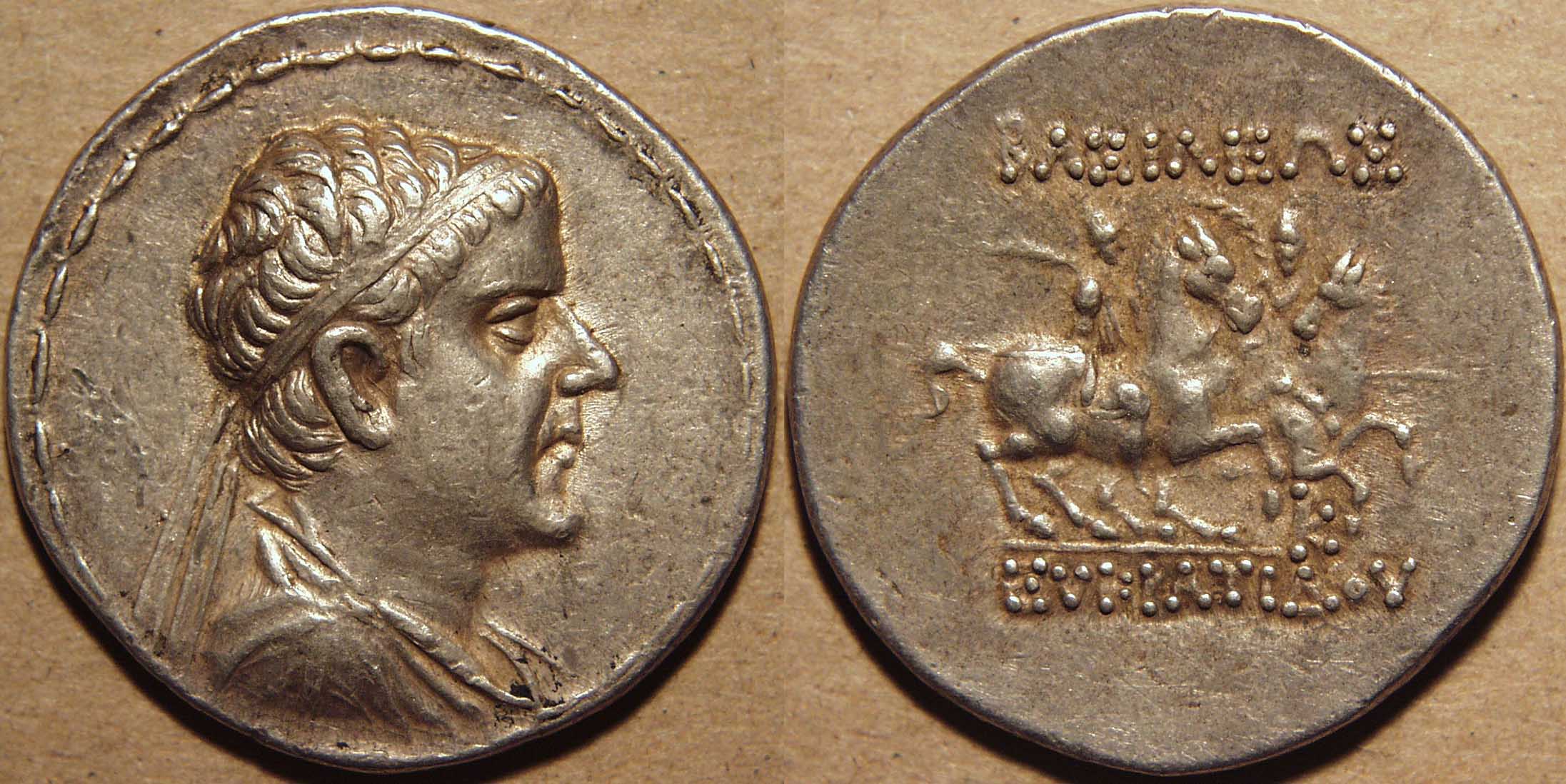
|
Bactria: Eucratides I, Silver tetradrachm, c. 171-145 BCE
Weight: 16.94 gm., Diam: 33 mm., Die axis: 12 h
Diademed bust of king facing right, bead and reel border around /
Dioscuri riding horses prancing right, carrying spears and palms
Greek legend: BAΣIΛEΩΣ EYKPATIΔOY (of King Eucratides)
|
 |
On his coin reverse, Eucratides chose to place the Dioscuri, the sons of Zeus, Castor and Pollux. Quite possibly, this was to emphasize his
own royal ancestry. The monolingual coinage used only Greek legends and conformed to the Attic weight standard. Presumably, it was issued in Bactria, north of the Hindu Kush
mountains. The bare-headed, diademed coinage seems to have been the initial coinage of Eucratides and appears to have had a relatively short issue period, to be replaced by the
more common and famous helmeted bust.
|
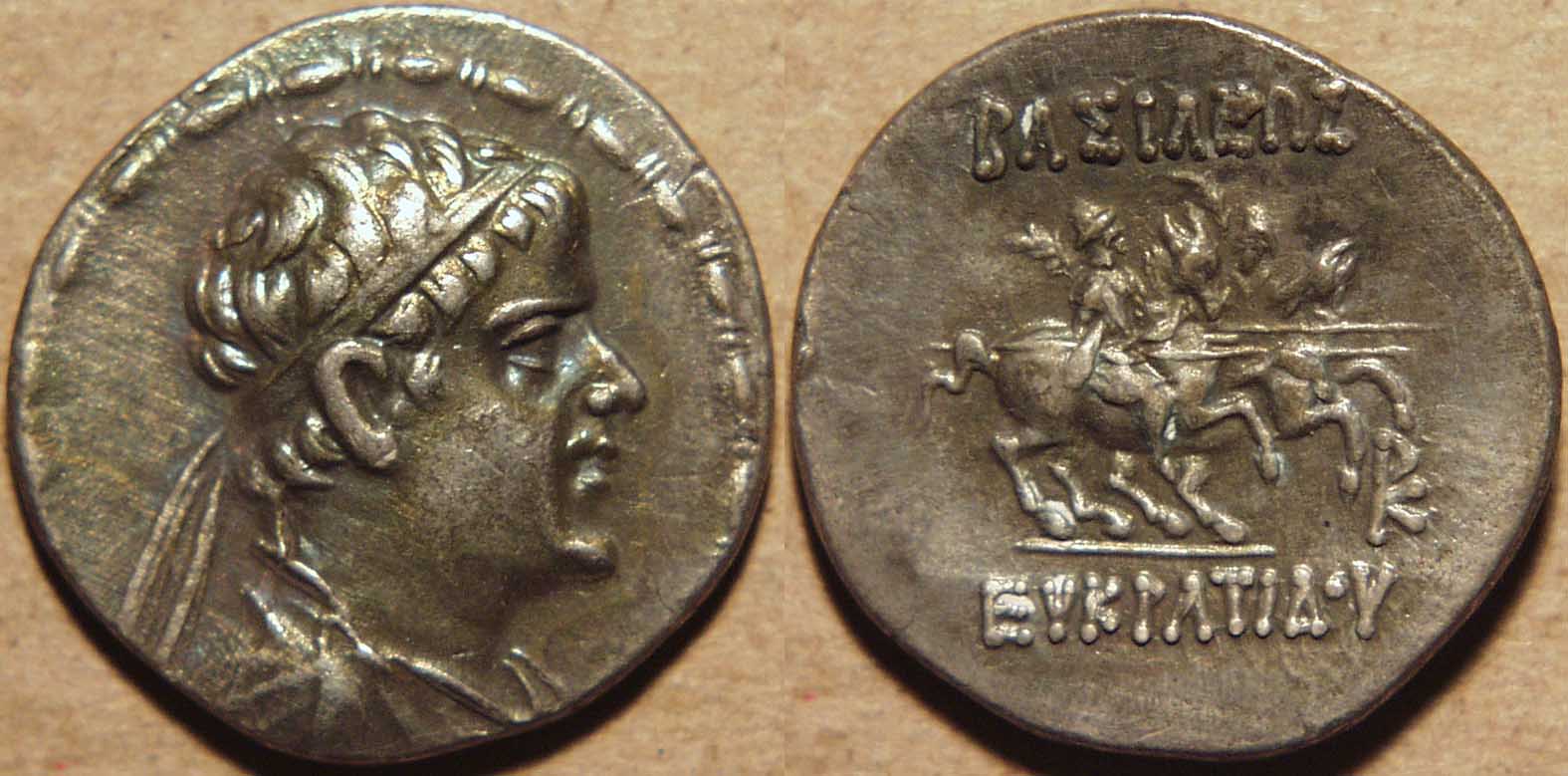
|
Bactria: Eucratides I, Silver drachm, c. 171-145 BCE
Weight: 4.08 gm., Diam: 19 mm., Die axis: 12 h
Diademed bust of king facing right, bead and reel border around /
Dioscuri riding horses prancing right, carrying spears and palms
Greek legend: BAΣIΛEΩΣ EYKPATIΔOY (of King Eucratides)
|

|
Bactria: Eucratides I, Silver hemidrachm, c. 171-145 BCE
Weight: 2.05 gm., Diam: na, Die axis: 12 h
Diademed bust of king facing right, dotted border around /
Dioscuri standing facing, holding spears and palms
Greek legend: BAΣIΛEΩΣ EYKPATIΔOY (of King Eucratides)
(photo courtesy CNG)
|
 |
A recently discovered type that is so far known from only one specimen. It is important in that it shows the reverse type of the standing
Dioscuri, a design used in the similar-sized bilingual Indian-weight drachms later (see below). Unfortunately, the auctioneer did not publish the diameter of the coin, so its relative size
here is only a guess.
|

|
Bactria: Eucratides I, Silver obol, c. 171-145 BCE
Weight: 0.68 gm., Diam: 12 mm., Die axis: 12 h
Diademed bust of king facing right, dotted border around /
Caps and palms of the Dioscuri
Greek legend: BAΣIΛEΩΣ EYKPATIΔOY (of King Eucratides)
|
 |
The pointed caps (the "pilei") were a defining attribute of the Dioscuri, and were used on the tiny obols to economize on space.
|

|
Bactria: Eucratides I, Silver obol, c. after 145 BCE
Weight: 0.46 gm., Diam: 10 mm., Die axis: 12 h
Diademed bust of king facing right /
Caps and palms of the Dioscuri
Greek legend: BAΣIΛEΩΣ EYKPATIΔOY (of King Eucratides)
|
 |
The crude style of this coin suggests it may be a later, posthunous issue. It may have been issued by the nomadic tribes that overran Ai
Khanoum.
|
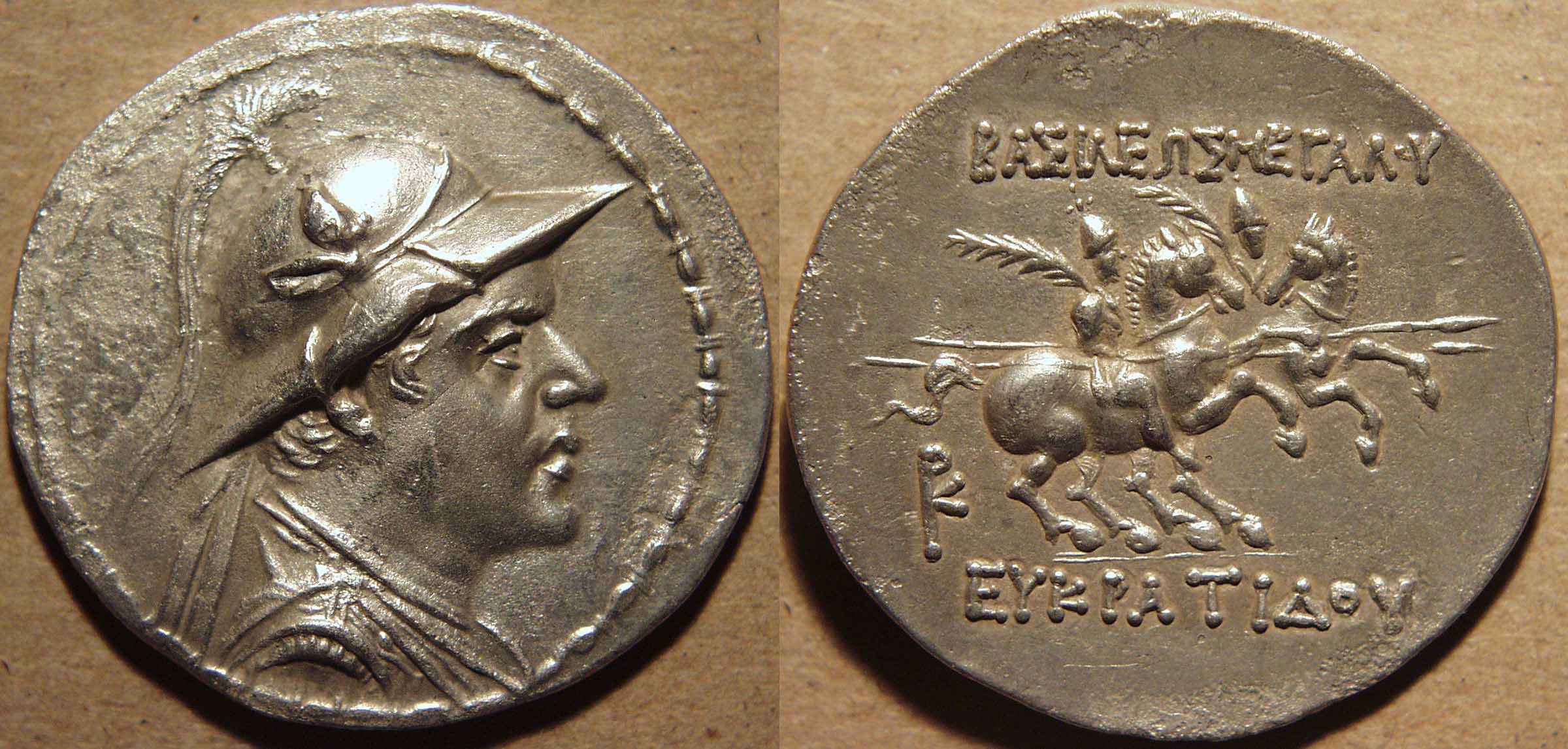
|
Bactria: Eucratides I, Silver tetradrachm, c. 171-145 BCE
Weight: 16.71 gm., Diam: 34 mm., Die axis: 12 h
Helmeted and diademed bust of king facing right, bead and reel border around,
the helmet plumed and decorated with the ear and horn of a bull /
Dioscuri riding horses prancing right, carrying spears and palms
Greek legend: BAΣIΛEΩΣ MEΓAΛOY EYKPATIΔOY (of Great King Eucratides)
|
 |
The famous helmeted type of Eucratides added the word Megas (Great) to the reverse legend. This rare early variety of the type
follows the bare-headed type in placing the legend in straight lines, an arrangement that left too little space for the two words in the top line ... hence we see a circular pattern being
introduced for that line in subsequent issues. The use of the title "Megas" was an innovation of Eucratides, and this title was imitated by a usurper of the Seleucid throne, Timarchus
of Media, around 163-161 BCE. Thus the Megas type of Eucratides must have been introduced before that time.
|
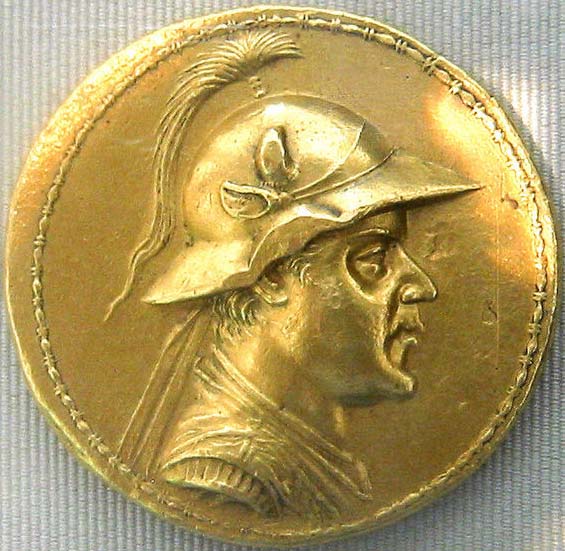
|
Bactria: Eucratides I, Gold 20-stater, c. 171-145 BCE
Weight: 169.2 gm., Diam: 58 mm., Die axis: 12 h
Helmeted and diademed bust of king facing right, bead and reel border around,
the helmet plumed and decorated with the ear and horn of a bull /
Dioscuri riding horses prancing right, carrying spears and palms
Greek legend: BAΣIΛEΩΣ MEΓAΛOY EYKPATIΔOY (of Great King Eucratides)
(photo of obverse, courtesy Wikipedia; of reverse, courtesy Osmund Bopearachchi)
|

|
One of the most famous ancient coins, the massive gold 20-stater of Eucratides, now in the collection of the National Library in Paris, was
surely also the largest gold coin minted in antiquity. It may well have been a victory medal to celebrate Eucratides's conquest of "India," presumably some land south of the Hindu
Kush, perhaps Gandhara.
An interesting thing about this particular coin pointed out by Osmund Bopearachchi is that, although the reverse legend is inscribed with the first two words in a circular pattern (as
on the next coin), it is clear that the legend had originally been inscribed in a horizontal arrangement (as on the previous coin). Presumably, a decision was made that the horizontal
arrangement was not satisfactory.
A Note on Image Sizes: On the web, it is impossible to present coin images in their actual sizes, the way they can be in print. Throughout the CoinIndia website, however, an
attempt has been made to present the coins in sizes proportional to one another. Thus a coin that has twice the diameter as another coin will be shown as double in size.
This is so that visitors can get a sense of the actual relative sizes of the coins. That is why this coin is shown almost three times the size of the next one, as its diameter (58 mm) is
almost three times the diameter of the stater (20 mm). Wherever possible, the actual diameter (for round coins) or dimensions (for rectangular or oddly-shaped
coins) is provided. Of course, enlargements of each coin are available by clicking on the images.
|
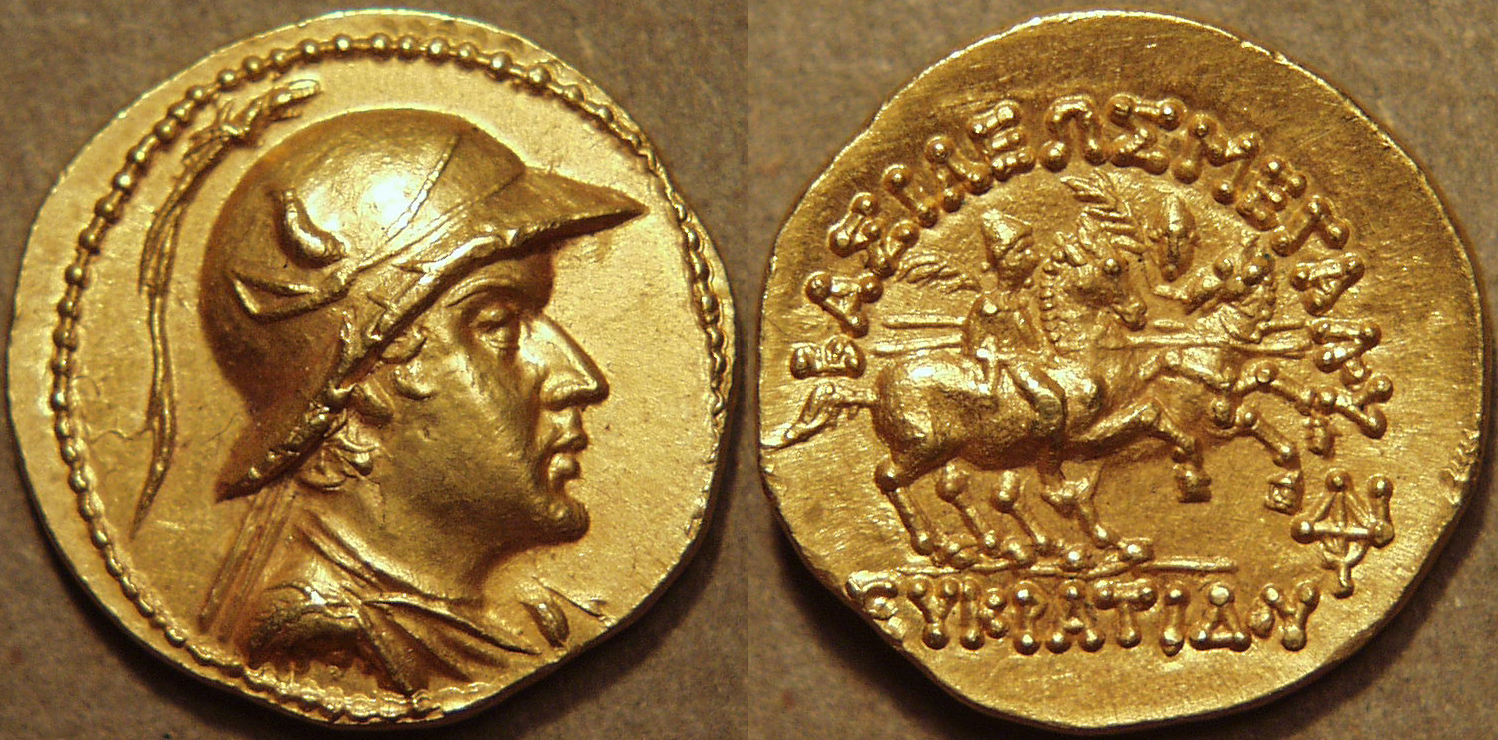
|
Bactria: Eucratides I, Gold stater, c. 171-145 BCE
Weight: 8.47 gm., Diam: 20 mm., Die axis: 12 h
Helmeted and diademed bust of king facing right, dotted border around,
the helmet plumed and decorated with the ear and horn of a bull /
Dioscuri riding horses prancing right, carrying spears and palms
Greek legend: BAΣIΛEΩΣ MEΓAΛOY EYKPATIΔOY (of Great King Eucratides)
|
 |
On this and subsequent issues of the helmeted type, the first two words of the reverse legend are inscribed in a semi-circular pattern, in
order to allow the letters to be of the requisite size.
|
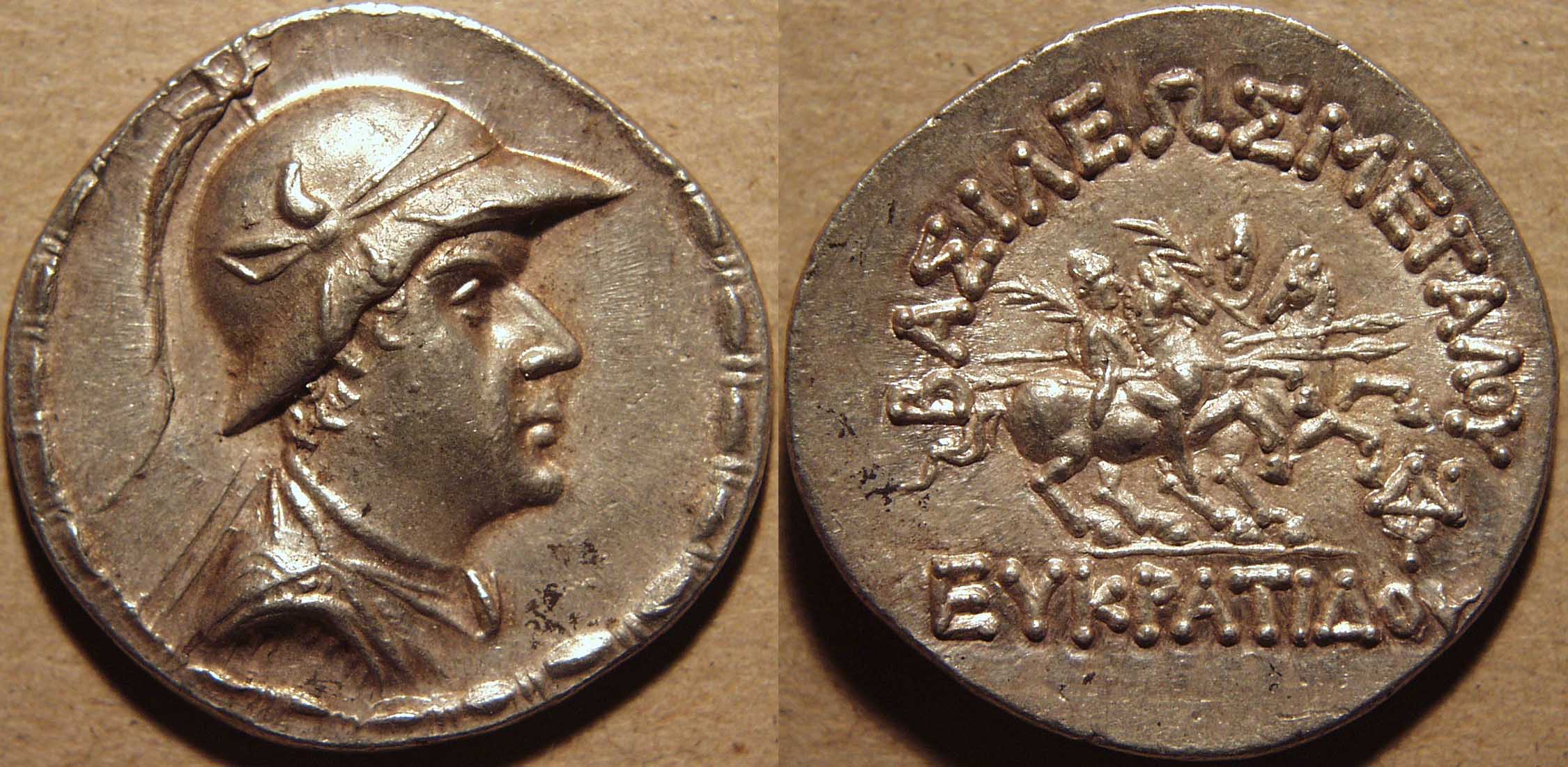
|
Bactria: Eucratides I, Silver tetradrachm, c. 171-145 BCE
Weight: 16.97 gm., Diam: 32 mm., Die axis: 12 h
Helmeted and diademed bust of king facing right, bead and reel border around,
the helmet plumed and decorated with the ear and horn of a bull /
Dioscuri riding horses prancing right, carrying spears and palms
Greek legend: BAΣIΛEΩΣ MEΓAΛOY EYKPATIΔOY (of Great King Eucratides)
|
 |
The helmeted Eucratides tetradrachm is one of the most popular and sought-after coins of the Bactrian series. Certainly it boasts a
wonderful portrait.
|
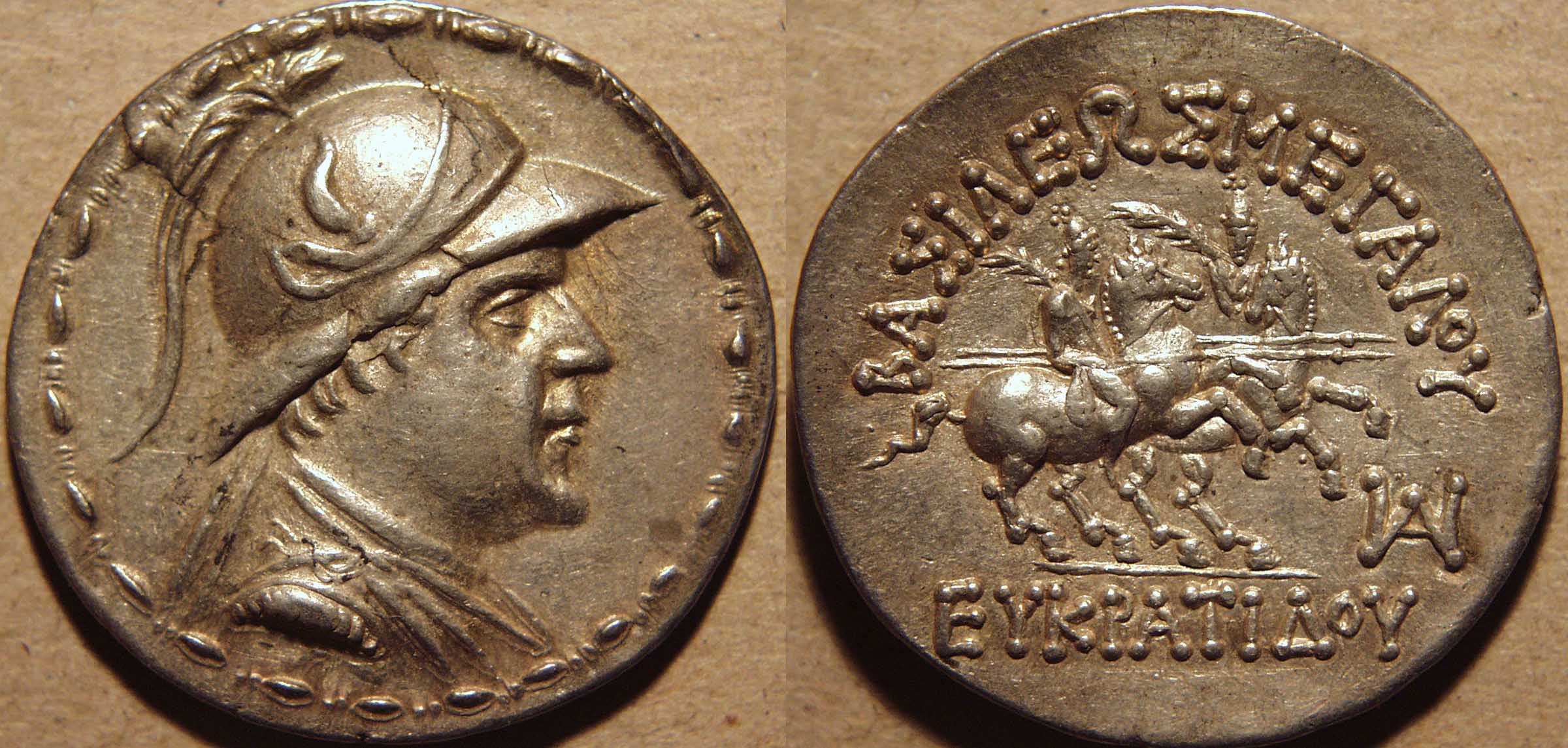
|
Bactria: Eucratides I, Silver tetradrachm, c. 171-145 BCE
Weight: 16.96 gm., Diam: 34 mm., Die axis: 12 h
Helmeted and diademed bust of king facing right, bead and reel border around,
the helmet plumed and decorated with the ear and horn of a bull /
Dioscuri riding horses prancing right, carrying spears and palms
Greek legend: BAΣIΛEΩΣ MEΓAΛOY EYKPATIΔOY (of Great King Eucratides)
|

|
Bactria: Eucratides I, Silver tetradrachm, c. 171-145 BCE
Weight: 17.18 gm., Diam: 33 mm., Die axis: 12 h
Helmeted and diademed bust of king facing right, bead and reel border around,
the helmet plumed and decorated with the ear and horn of a bull /
Dioscuri riding horses prancing right, carrying spears and palms
Greek legend: BAΣIΛEΩΣ MEΓAΛOY EYKPATIΔOY (of Great King Eucratides)
|
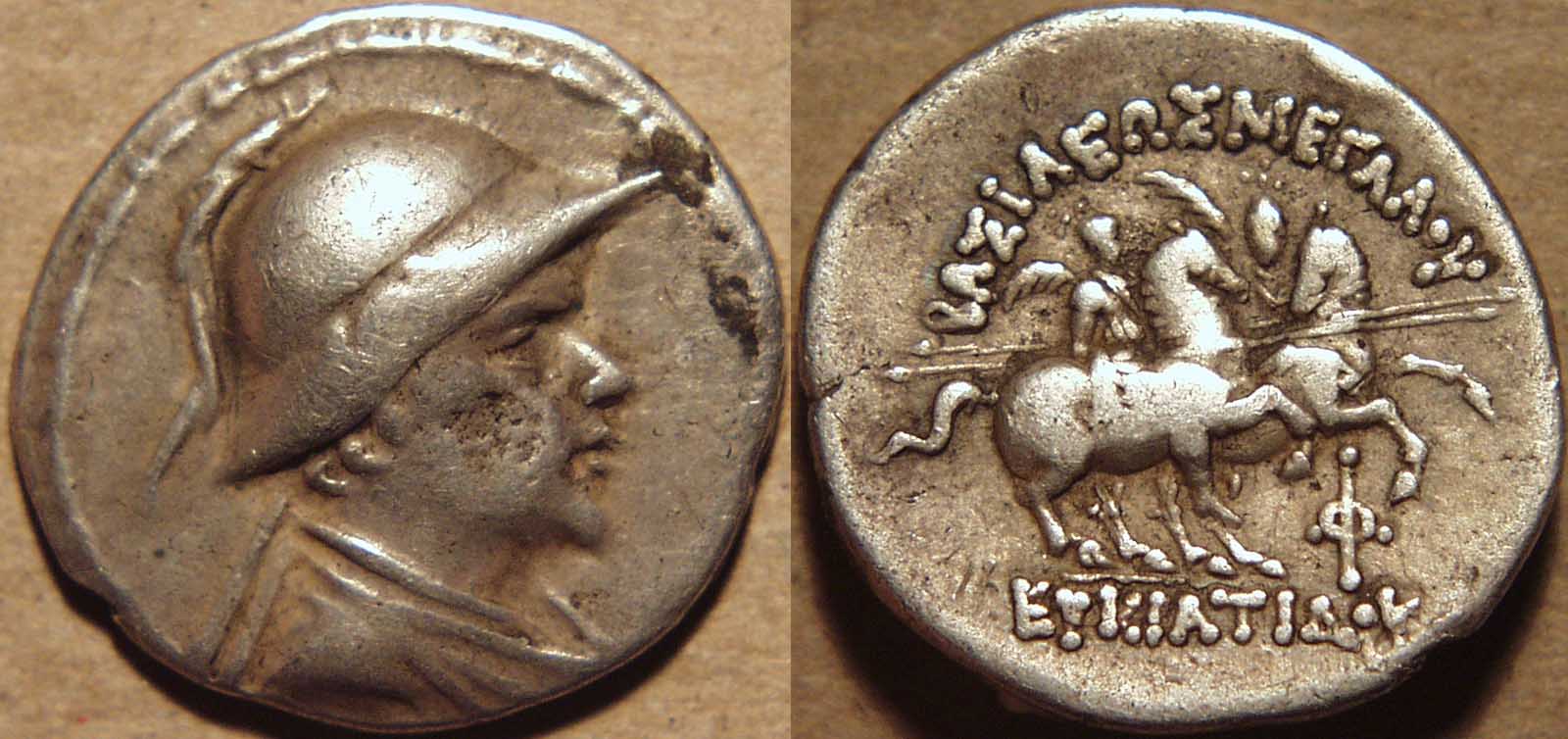
|
Bactria: Eucratides I, Silver drachm, c. 171-145 BCE
Weight: 4.05 gm., Diam: 19 mm., Die axis: 12 h
Helmeted and diademed bust of king facing right, bead and reel border around,
the helmet plumed and decorated with the ear and horn of a bull /
Dioscuri riding horses prancing right, carrying spears and palms
Greek legend: BAΣIΛEΩΣ MEΓAΛOY EYKPATIΔOY (of Great King Eucratides)
|

|
Bactria: Eucratides I, Silver drachm, perhaps after c. 145 BCE
Weight: 4.15 gm., Diam: 20 mm., Die axis: 12 h
Helmeted and diademed bust of king facing right, dotted border around,
the helmet plumed and decorated with the ear and horn of a bull /
Dioscuri riding horses prancing right, carrying spears and palms
Greek legend: BAΣIΛEΩΣ MEΓAΛOY EYKPATIΔOY (of Great King Eucratides)
|
 |
The monogram on this drachm is not previously attested for Eucratides. That fact, along with the crude style of the coin, suggests it might
be a posthumous imitative issue.
|

|
Bactria: Eucratides I, Silver obol, c. 171-145 BCE
Weight: 0.61 gm., Diam: 11 mm., Die axis: 12 h
Helmeted and diademed bust of king facing right, dotted border around,
Caps and palms of the Dioscuri
Greek legend: BAΣIΛEΩΣ EYKPATIΔOY (of King Eucratides)
|

|
Bactria: Eucratides I, Silver hemi-obol, c. 171-145 BCE
Weight: 0.27 gm., Diam: 9 mm., Die axis: 12 h
Helmeted and diademed bust of king facing right, dotted border around,
Caps and palms of the Dioscuri
Greek legend: BAΣIΛEΩΣ EYKPATIΔOY (of King Eucratides)
|
 |
The low weight and small size of this coin, including the small sizes of all the devices on it, mark this as a true hemi-obol rather than an
obol. The denomination is unlisted in all the usual catalogs.
|
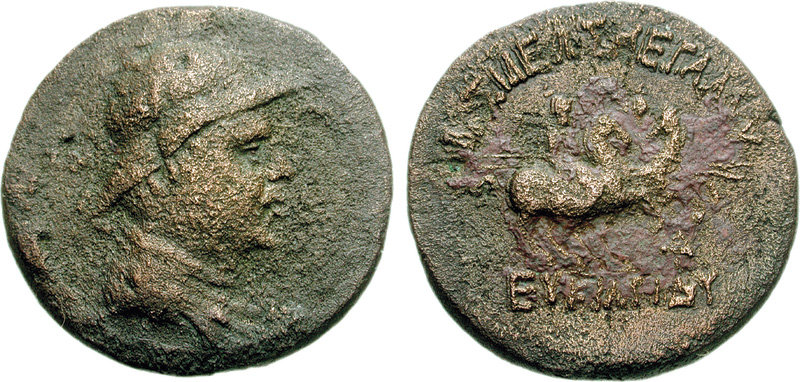
|
Bactria: Eucratides I, Bronze octuple, c. 171-145 BCE
Weight: 29.59 gm., Diam: na, Die axis: 12 h
Helmeted and diademed bust of king facing right, border around,
the helmet plumed and decorated with the ear and horn of a bull /
Dioscuri riding horses prancing right, carrying spears and palms
Greek legend: BAΣIΛEΩΣ MEΓAΛOY EYKPATIΔOY (of Great King Eucratides)
(photo courtesy CNG)
|
 |
Another recently discovered denomination, so far known only from this one specimen. Once again, the size of the coin is a guess, since the
auctioneer did not publish its diameter.
|

|
Bactria: Eucratides I, Bronze quadruple, c. 171-145 BCE
Weight: 15.80 gm., Diam: na, Die axis: 12 h
Helmeted and diademed bust of king facing right, border around,
the helmet plumed and decorated with the ear and horn of a bull /
Dioscuri riding horses prancing right, carrying spears and palms
Greek legend: BAΣIΛEΩΣ MEΓAΛOY EYKPATIΔOY (of Great King Eucratides)
(photo courtesy CNG)
|
 |
Once again, the size of the coin is a guess, since the auctioneer did not publish its diameter.
|

|
Bactria: Eucratides I, Bronze double, c. 171-145 BCE
Weight: 6.83 gm., Diam: 23 mm, Die axis: 1 h
Helmeted and diademed bust of king facing right, bead and reel border around,
the helmet plumed and decorated with the ear and horn of a bull /
Dioscuri riding horses prancing right, carrying spears and palms
Greek legend: BAΣIΛEΩΣ MEΓAΛOY EYKPATIΔOY (of Great King Eucratides)
|
 |
Bopearachchi classifies all the monolingual bronze doubles as posthumous. However, it would seem odd that Eucratides, having issued
octuples, quadruples, and single unit bronzes, would not have issued double units also. Further, the style of this coin seems to be quite good and perfectly consistent with the
official lifetime issues.
|
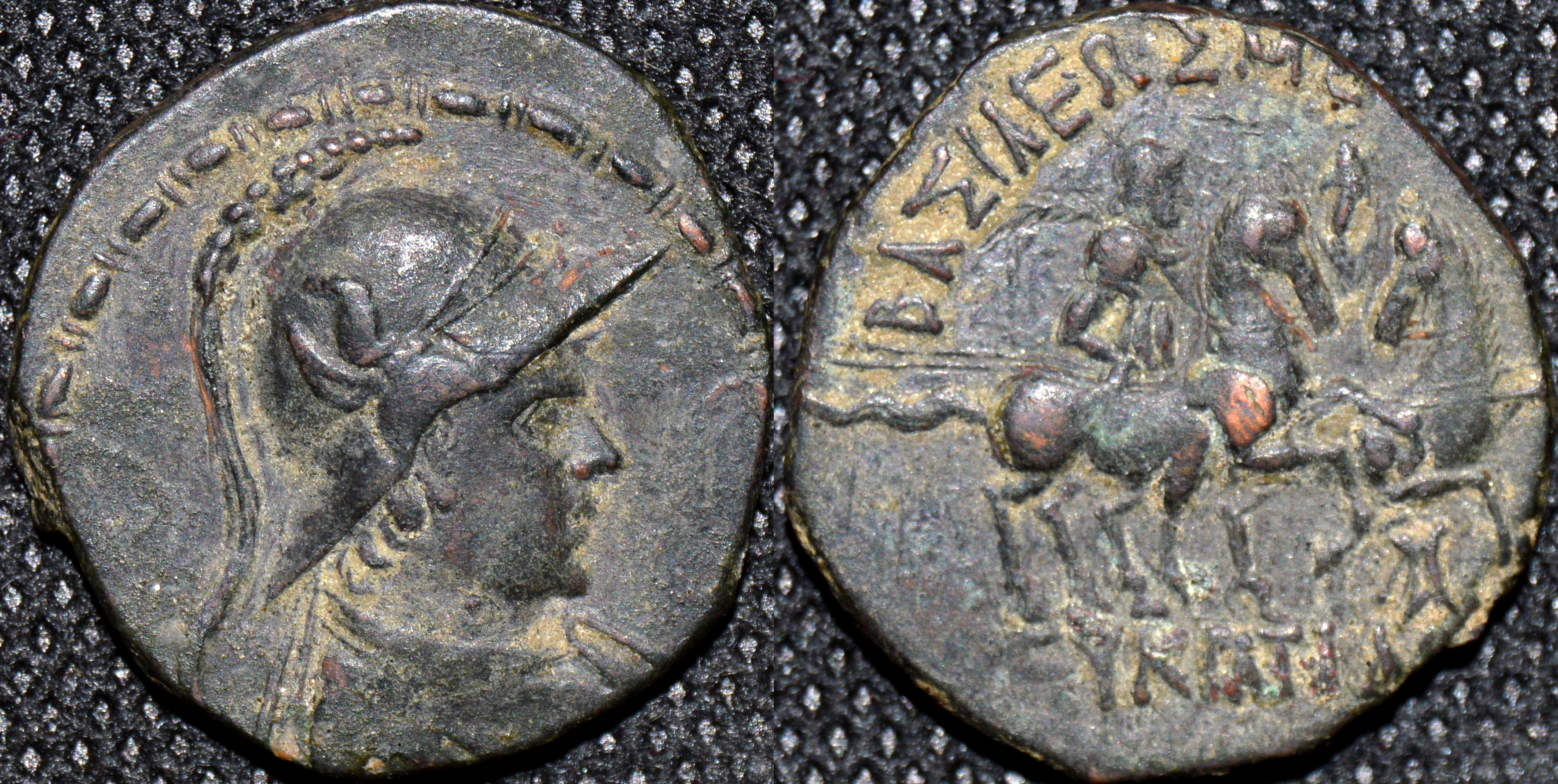
|
Bactria: Eucratides I, Bronze double, c. 171-145 BCE
Weight: 6.26 gm., Diam: 22 mm, Die axis: 12 h
Helmeted and diademed bust of king facing right, bead and reel border around,
the helmet plumed and decorated with the ear and horn of a bull /
Dioscuri riding horses prancing right, carrying spears and palms
Greek legend: BAΣIΛEΩΣ MEΓAΛOY EYKPATIΔOY (of Great King Eucratides)
Ref: MIG 186a, Bop 21C
|
 |
A lovely example of the type.
|

|
Bactria: Eucratides I, Bronze single unit, c. 171-145 BCE
Weight: 2.70 gm., Diam: 14 mm, Die axis: 12 h
Helmeted and diademed bust of king facing right, bead and reel border around,
the helmet plumed and decorated with the ear and horn of a bull /
Dioscuri riding horses prancing right, carrying spears and palms
Greek legend: BAΣIΛEΩΣ MEΓAΛOY EYKPATIΔOY (of Great King Eucratides)
|
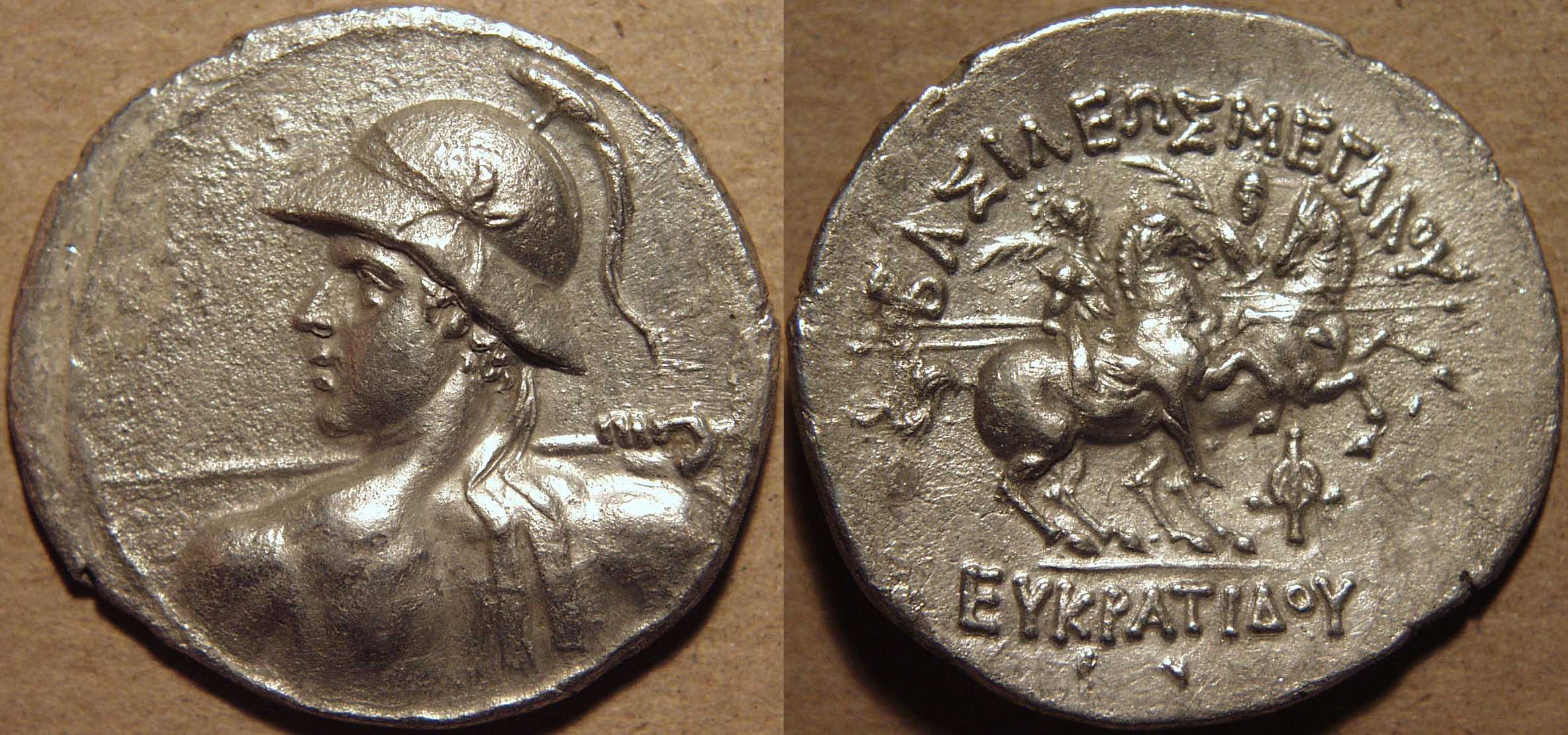
|
Bactria: Eucratides I, Silver tetradrachm, c. 171-145 BCE
Weight: 16.13 gm., Diam: 34 mm., Die axis: 12 h
Helmeted and diademed bust of king seen from behind, ruled border around,
the helmet plumed and decorated with the ear and horn of a bull
and the king holding a spear in a thrusting position /
Dioscuri riding horses prancing right, carrying spears and palms
Greek legend: BAΣIΛEΩΣ MEΓAΛOY EYKPATIΔOY (of Great King Eucratides)
|
 |
This type, sometimes referred to as the "Spearthruster" or "Heroic" type was an innovation on the part of Eucratides and was imitated by
many of the subsequent Greek kings in India.
|
 |
 |
 |
Pedigree Issues |

|
Bactria: Eucratides I, Silver tetradrachm, c. 171-145 BCE
Weight: 17.00 gm., Diam: 32 mm., Die axis: 12 h
Helmeted and diademed bust of king facing right, bead and reel border around,
the helmet plumed and decorated with the ear and horn of a bull,
Greek legend: BAΣIΛEYΣ MEΓAΣ / EYKPATIΔHΣ (Great King Eucratides) /
Jugate busts of Heliocles and Laodice, Laodice wearing diadem,
Greek legend: HΛIOKΛEOYΣ / KAI ΛAOΔIKHΣ (Heliocles and Laodice),
Bead and reel border around
|
 |
Heliocles and Laodice were presumably the parents of Eucratides. Since only Laodice wears the diadem (the thin band running over her
head), we can infer that she alone was of royal blood. An interesting aspect of the legends on this coin is that they are in the nominative, rather than the usuual genitive, case.
|
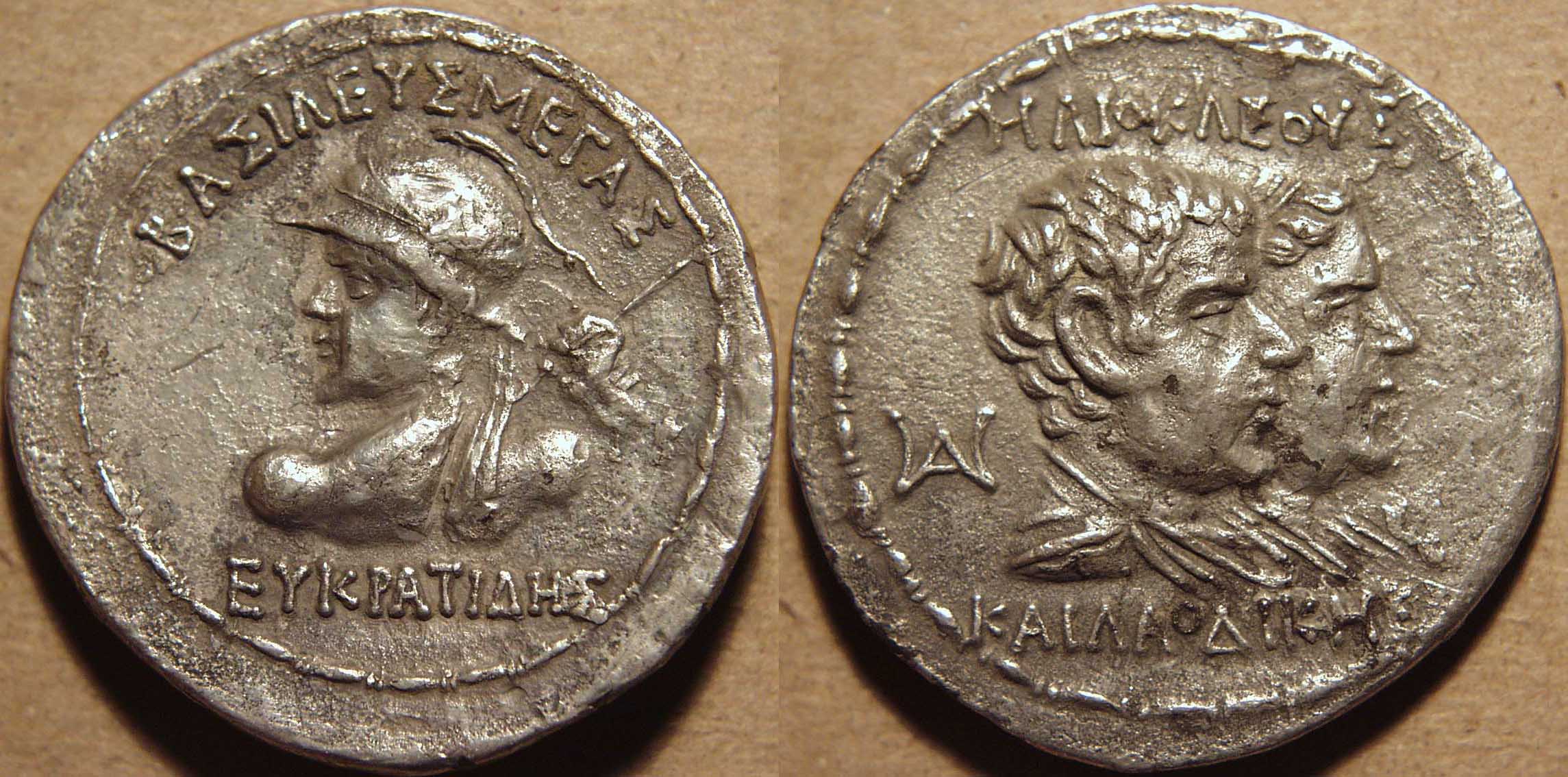
|
Bactria: Eucratides I, Silver tetradrachm, c. 171-145 BCE
Weight: 14.76 gm., Diam: 33 mm., Die axis: 12 h
Helmeted and diademed bust of king seen from behind, bead and reel border around,
the helmet plumed and decorated with the ear and horn of a bull
and the king holding a spear in a thrusting position,
Greek legend: BAΣIΛEYΣ MEΓAΣ / EYKPATIΔHΣ (Great King Eucratides) /
Jugate busts of Heliocles and Laodice, Laodice wearing diadem,
Greek legend: HΛIOKΛEOYΣ / KAI ΛAOΔIKHΣ (Heliocles and Laodice),
Bead and reel border around
|
 |
Bilingual Issues |

|
Indo-Greek: Eucratides I, Silver drachm (Indian standard), c. 171-145 BCE
Weight: 1.50 gm., Diam: 16 mm, Die axis: 12 h
Helmeted and diademed bust of king facing right, bead and reel border around,
the helmet plumed and decorated with the ear and horn of a bull,
Greek legend: BAΣIΛEΩΣ MEΓAΛOY EYKPATIΔOY (of Great King Eucratides)
Dioscuri standing facing, nude, holding spears and palms
Kharoshthi legend: rajasa mahatakasa / evukratidasa (of Great King Eucratides)
|
 |
The difference between coins that are classified as "Bactrian" or "Greco-Bactrian" on the one hand, and "Indo-Greek" on the other, is
that the legends on the Bactrian coins are in Greek only, while the Indo-Greek coins have legends in both Greek and an Indian script, normally Kharoshthi, although occasionally in
Brahmi. The Bactrian coins were issued in Bactria only, north of the Hindu Kush mountains, while the Indo-Greek coins were issued south of the Hindu Kush. This and the other
Indo-Greek coins issued by Eucratides demonstrate that he had an extensive kingdom in Gandhara in addition to his Bactrian domains.
Almost all of the known Indo-Greek style coinage of Eucratides is in copper or bronze; the silver coins such as this one are very rare. This must have been a very early issue, as it is
round in shape, just like the Bactrian issues. However, it appears the Indians had a preference for rectangular coins, like the Mauryan coins to
which they were accustomed and the next coin is an attempt to satisfy this preference.
|

|
Indo-Greek: Eucratides I, Silver drachm (Indian standard), c. 171-145 BCE
Weight: 1.01 gm., Dim: 16 x 15 mm, Die axis: 12 h
Helmeted and diademed bust of king facing right,
the helmet plumed and decorated with the ear and horn of a bull,
Greek legend: BAΣIΛEΩΣ MEΓAΛOY EYKPATIΔOY (of Great King Eucratides)
Dioscuri standing facing, nude, holding spears and palms
Kharoshthi legend: rajasa mahatakasa / evukratidasa (of Great King Eucratides)
|
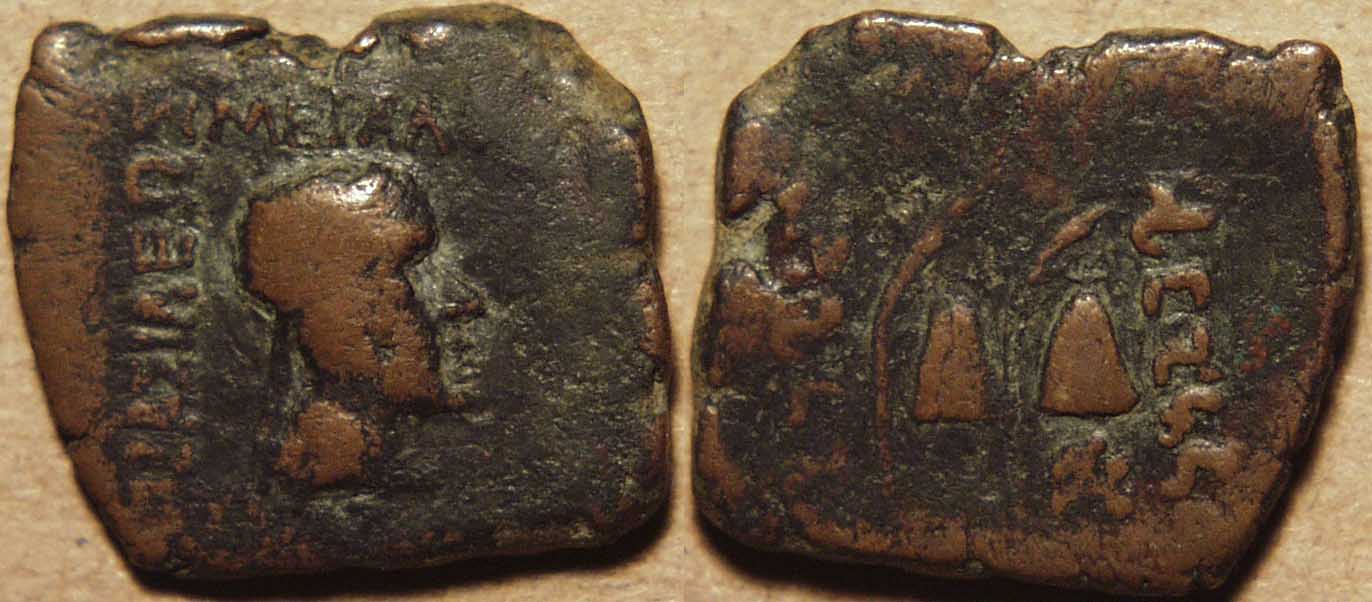
|
Indo-Greek: Eucratides I, AE unit, c. 171-145 BCE
Weight: 2.27 gm., Dim: 16 x 14 mm, Die axis: 12 h
Bare-headed, diademed bust of king facing right,
Greek legend: BAΣIΛEΩΣ MEΓAΛOY EYKPATIΔOY (of Great King Eucratides)
Caps and palms of the Dioscuri
Kharoshthi legend: maharajasa / evukratidasa (of King Eucratides)
|
 |
These coins, which are quite scarce, are a bit of a surprise, as they indicate that Eucratides conquered territory south of the Hindu Kush
and issued coins there before he introduced his helmeted type. Thus his successes south of the Hindu Kush came relatively early in his reign.
|

|
Indo-Greek: Eucratides I, AE 16-units, c. 171-145 BCE
Weight: 28.51 gm., Diam: na, Die axis: 12 h
Helmeted and diademed bust of king facing right,
Greek legend: BAΣIΛEΩΣ MEΓAΛOY EYKPATIΔOY (of Great King Eucratides)
Dioscuri mounted on horses prancing right, holding spears and palms,
Kharoshthi legend: maharajasa / evukratidasa (of King Eucratides)
(photo courtesy CNG)
|
 |
It is interesting to note that on none of his bilingual bronze coinage does Eucratides translate the Greek MEΓAΛOY (Great)
into the Prakrit legend on the reverse. The silver coins (see above) did carry the word mahatakasa but this was omitted on all the base metal coinage.
|
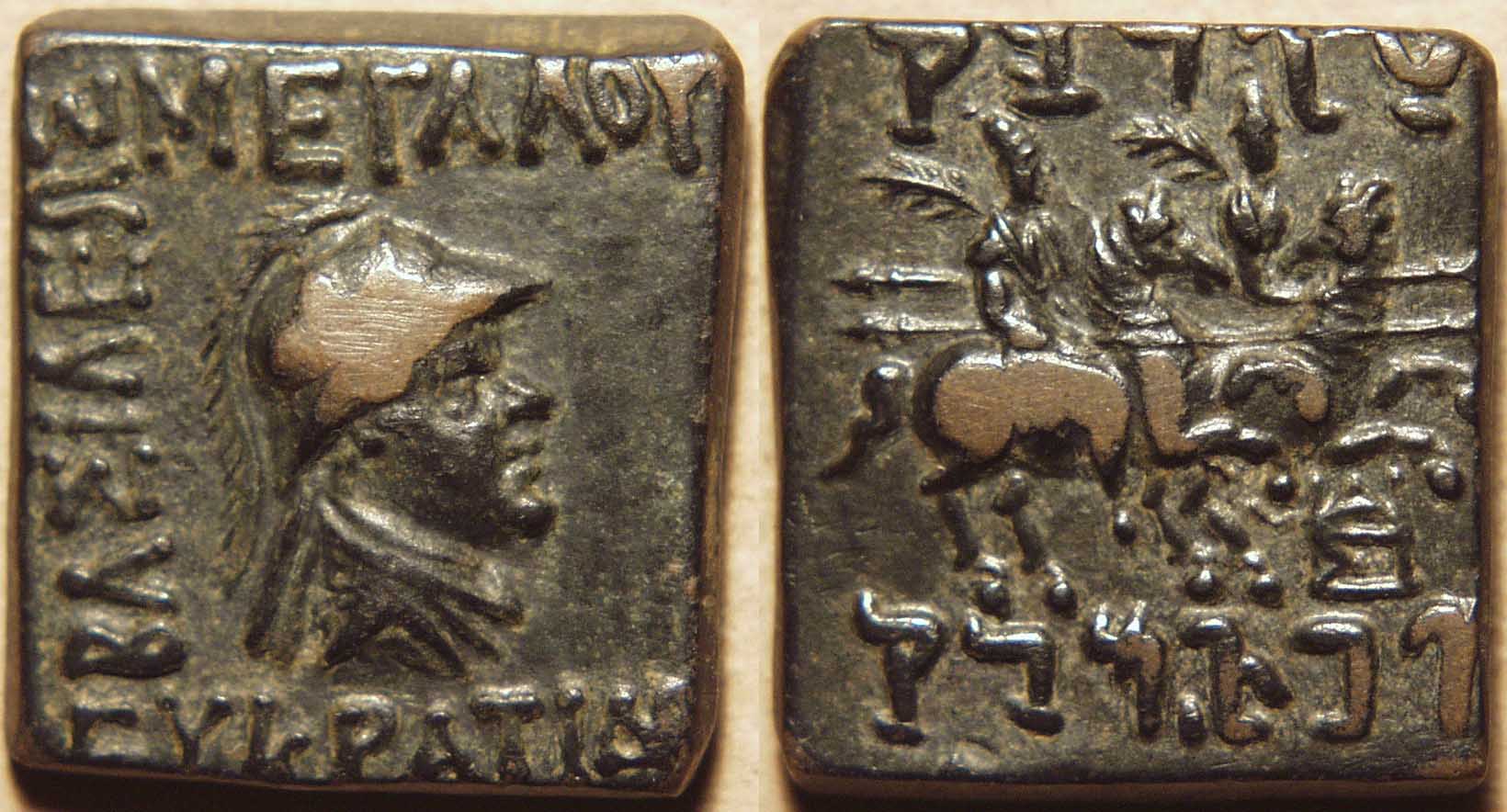
|
Indo-Greek: Eucratides I, AE quadruple, c. 171-145 BCE
Weight: 8.65 gm., Dim: 19 x 20 mm, Die axis: 12 h
Helmeted and diademed bust of king facing right,
Greek legend: BAΣIΛEΩΣ MEΓAΛOY EYKPATIΔOY (of Great King Eucratides)
Dioscuri mounted on horses prancing right, holding spears and palms,
Kharoshthi legend: maharajasa / evukratidasa (of King Eucratides)
|

|
Indo-Greek: Eucratides I, AE double, c. 171-145 BCE
Weight: 3.27 gm., Dim: 20 x 21 mm, Die axis: 12 h
Helmeted and diademed bust of king facing right,
Greek legend: BAΣIΛEΩΣ MEΓAΛOY EYKPATIΔOY (of Great King Eucratides)
Dioscuri mounted on horses prancing right, holding spears and palms,
Kharoshthi legend: maharajasa / evukratidasa (of King Eucratides)
|
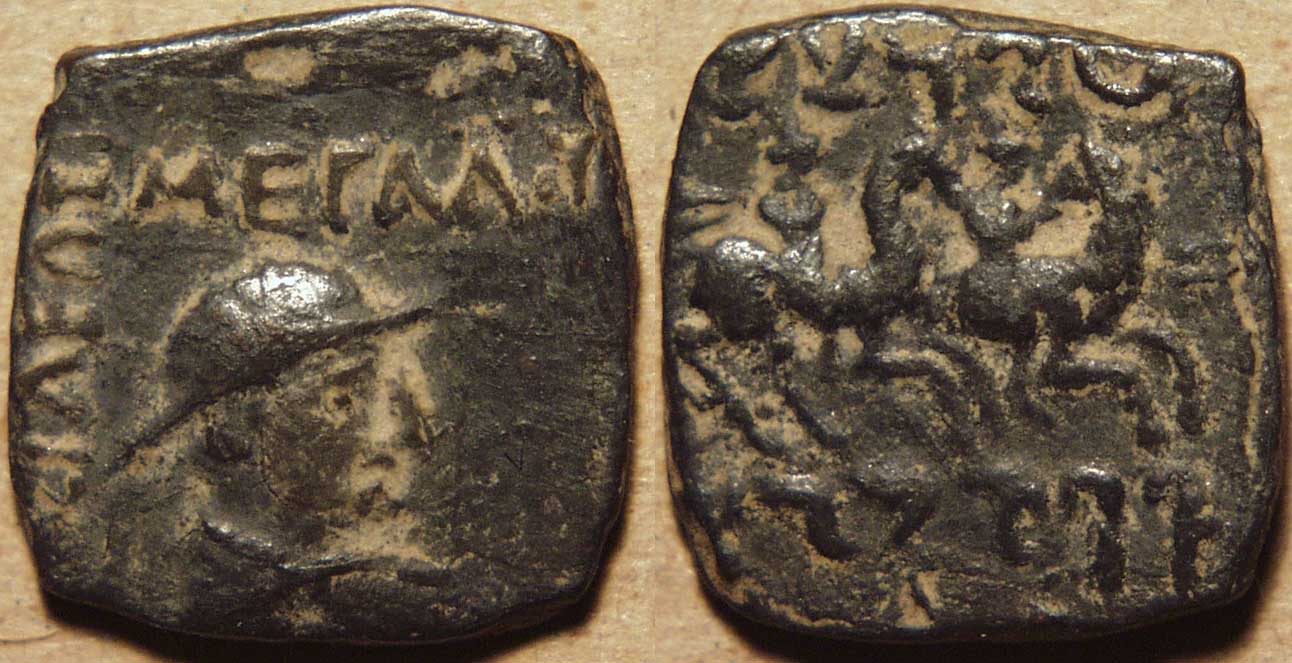
|
Indo-Greek: Eucratides I, AE single unit, c. 171-145 BCE
Weight: 2.26 gm., Dim: 15 x 15 mm, Die axis: 12 h
Helmeted and diademed bust of king facing right,
Greek legend: BAΣIΛEΩΣ MEΓAΛOY EYKPATIΔOY (of Great King Eucratides)
Dioscuri mounted on horses prancing right, holding spears and palms,
Kharoshthi legend: maharajasa / evukratidasa (of King Eucratides)
|
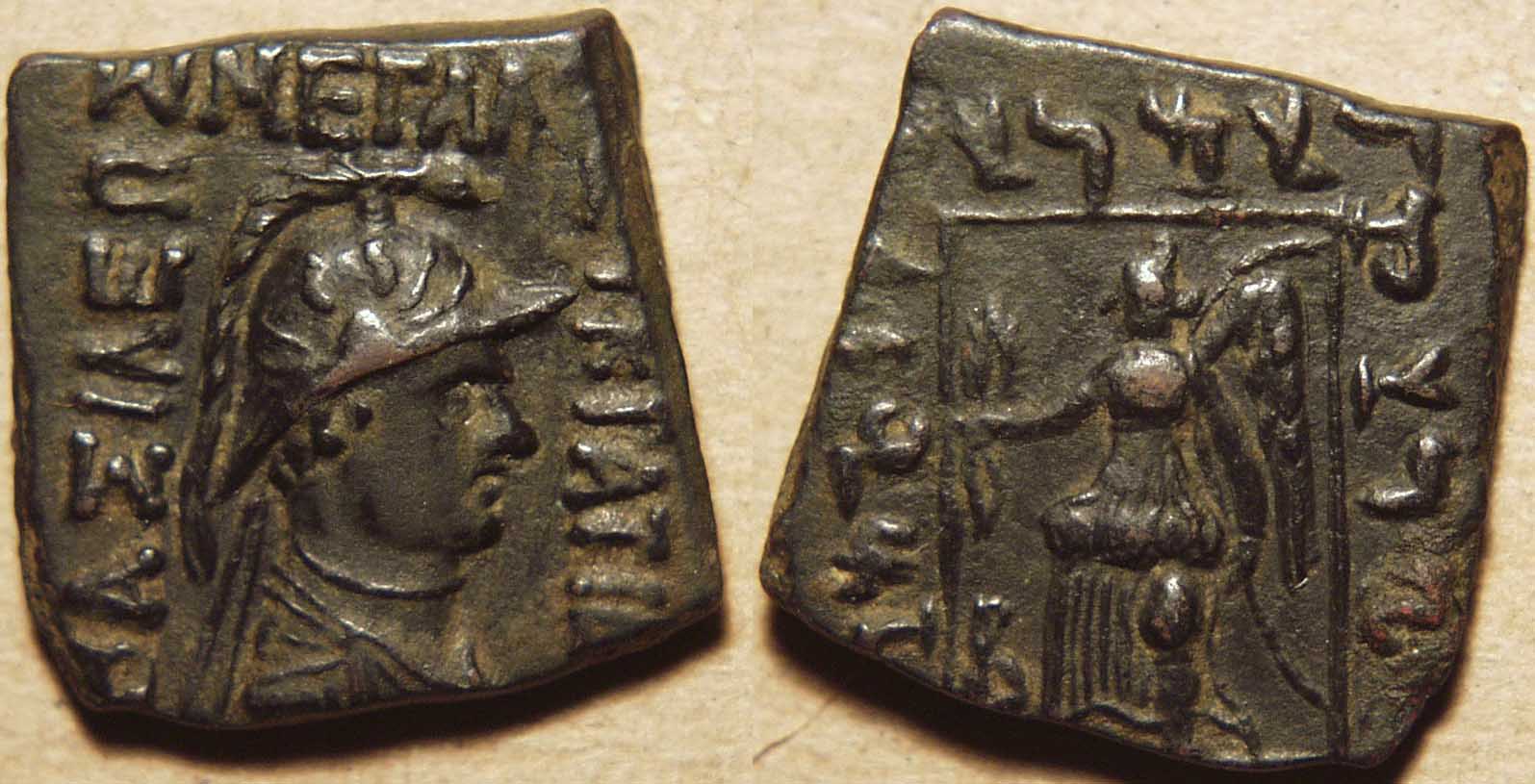
|
Indo-Greek: Eucratides I, AE double, c. 171-145 BCE
Weight: 4.02 gm., Dim: 18 x 17 mm, Die axis: 12 h
Helmeted and diademed bust of king facing right,
Greek legend: BAΣIΛEΩΣ MEΓAΛOY EYKPATIΔOY (of Great King Eucratides)
Winged Nike standing left, holding wreath and palm,
Kharoshthi legend: maharajasa / rajatirajasa / evukratidasa (of King Eucratides, King of Kings)
|
 |
On this coin, a new type with Nike on the reverse, there is an additional word on the reverse, but it is not the expected mahatakasa,
but instead the word rajatirajasa, or "king of kings." The Greek for this would have been BAΣIΛEΩN, but this is not present on the obverse.
|
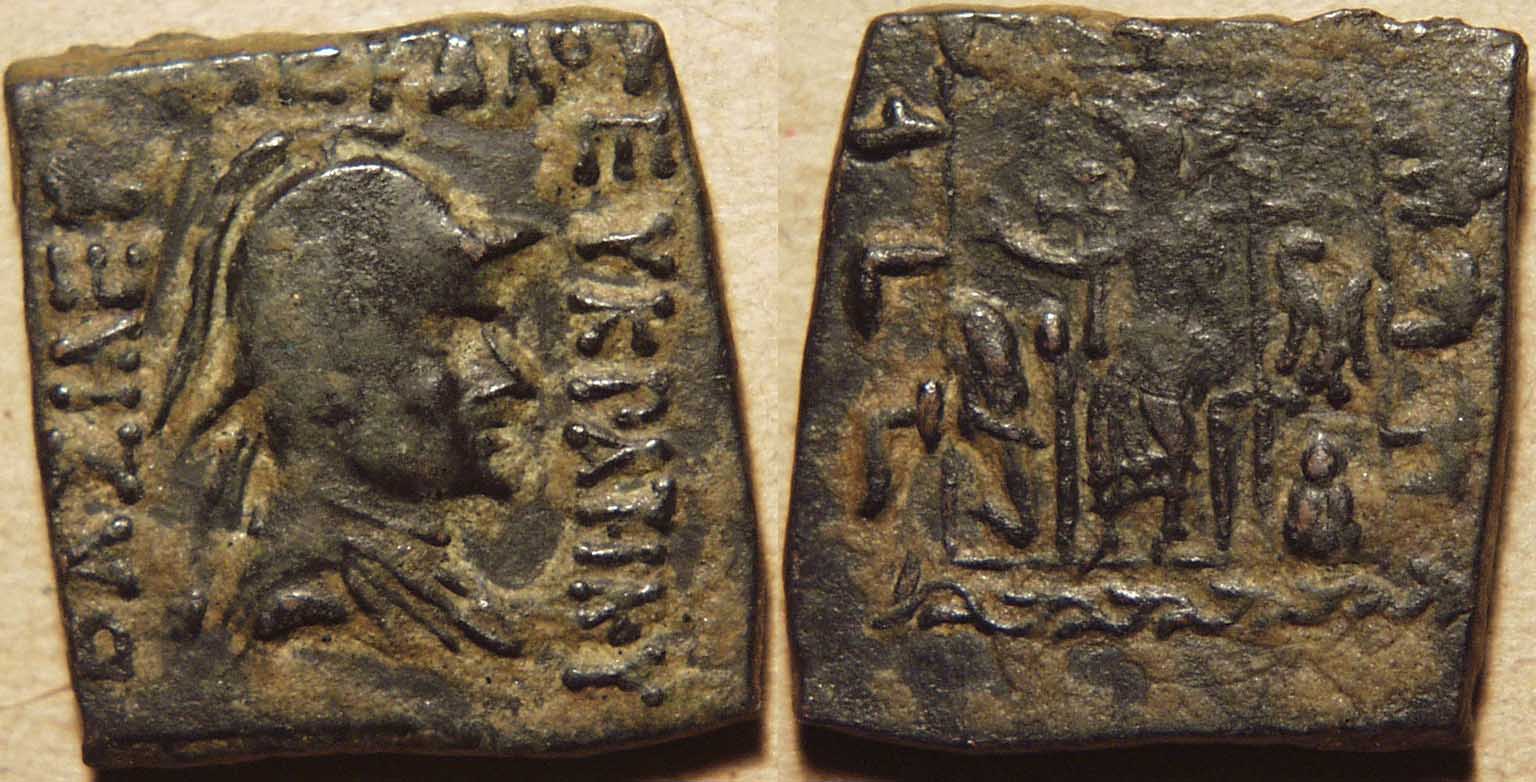
|
Indo-Greek: Eucratides I, AE double, c. 171-145 BCE
Weight: 4.69 gm., Dim: 17 x 18 mm, Die axis: 12 h
Helmeted and diademed bust of king facing right,
Greek legend: BAΣIΛEΩΣ MEΓAΛOY EYKPATIΔOY (of Great King Eucratides)
City Goddess of Kapisa enthroned, holding palm, forepart of elephant at left, mountain at right,
Kharoshthi legend: kavisiye nagara devata (deity of Kapisa City)
|
 |
A very interesting coin, featuring the City Goddess of Kapisa, who is identified as such by the reverse legend. On almost the entire Indo-Greek
series, the reverse legend is a faithful translation of the obverse Greek legend, but this coin is a radical departure from that pattern.
|
|
|